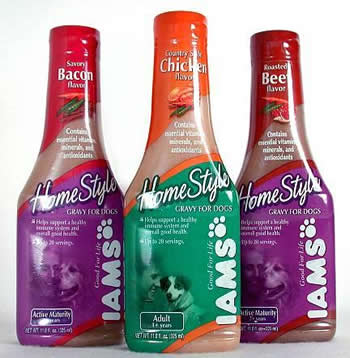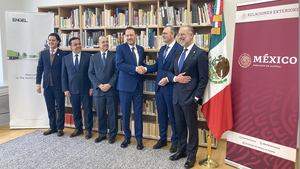A messy battle: Disparate groups work to solve full-wrap shrink sleeve label recycling issues
If you're an attendee of a conference, of any kind, typically the drama factor is pretty low, especially toward the end of the day when people are more concerned about if they will order steak or fish at dinner and if a bottle of wine is a bit excessive for a Tuesday night.
May 10, 2013
If you're an attendee of a conference, of any kind, typically the drama factor is pretty low, especially toward the end of the day when people are more concerned about if they will order steak or fish at dinner and if a bottle of wine is a bit excessive for a Tuesday night.
So it's safe to say it was pretty unexpected at The Packaging Conference (Feb. 4-6; Atlanta, GA) when inter-presenter disagreements moved front and center late in the day. The Tuesday afternoon session at The Packaging Conference focused on plastic recycling challenges and potential solutions. Tensions emerged when Tom Busard, chairman of the Association of Postconsumer Plastic Recyclers (APR), took issue with two of the presentations prior to his.
In her speech, Holli Whitt, market development manager of sustainability for Eastman Chemical, discussed the full-wrap label consortium that the company organized to develop solutions surrounding PET bottles and full-wrap labels in the recycle stream.
The group includes representatives from consumer goods manufacturers, resin producers, film extruders, print converters and label producers, equipment manufacturers, bottlers and packagers, plastics recyclers and independent testing firms.
Busard believed there's a key stakeholder missing in the consortium: the Association of Postconsumer Plastic Recyclers (APR).
"APR was not invited to any label consortium," he told the audience. "Holli said it included the entire supply chain ... if you are including the entire chain, it seemed like it would make sense to include APR from the start."
 Well, earlier this week the APR announced the formation of a Label Working Group in an effort to focus on the recycler's perspective on addressing full-wrap shrink sleeve labels.
Well, earlier this week the APR announced the formation of a Label Working Group in an effort to focus on the recycler's perspective on addressing full-wrap shrink sleeve labels.
The APR, whose members represent more than 90% of the processors of postconsumer plastic bottles in the United States, Canada and Mexico, formed the group in response to the growth of full bottle shrink wrap labels that are showing up in the marketplace.
"Full-wrap shrink sleeve labels are a critical issue facing plastics recycling today," said Steve Alexander, APR director, in the news release. "While they are extremely popular with brand owners, they represent a nightmare for most recyclers, and render the containers they cover mostly unrecyclable."
Full-wrap shrink labels are popular on food and beverage packaging along with household chemicals and personal care containers, but they come with challenges. A majority of PET reclaimers report that the labels create serious problems for recycling, with a potential loss of revenue to the local collection system and loss of raw material to the reclaiming community.
It seems the issue just isn't about PET bottles. Alexander said they are now seeing these full-wrap shrink labels contaminating polypropylene bottles and containers, which means the problem continues to grow.
One crucial issue, according to John Standish, APR's technical director, is that most sorting technology fails on two fronts.
"First, the sorting equipment cannot identify the resin composition of the container that the label is covering," he said. "Second, many of the labels are not properly removed in the washing process, causing the label to sink with the container in the normal sink/float process. This essentially contaminates the entire stream of material, and makes it unusable for a second life application."
Something that stuck out in the release was Alexander saying recyclers are the usually the last to know about these types of innovations.
"The innovator and creator of the innovation are the first to know, the container manufacturer and brand company are next," he said. "Only after the product is introduced in the market, and made available for recycling, is the recycler made aware of the innovation. The goal of APR is to work with innovators so they understand the implications on the recyclability of the container."
Alexander did point out that many technology and equipment manufacturers, major brand owners, and others are actively working to develop solutions to the problems.
"We look forward to working with the label manufacturers and other groups to develop a solution that works for all participants in the stream, from innovation to reclamation," he said. "The last thing a brand owner wants to see is a new innovation that they have invested in rendering their container non-recyclable. We do not want that either. Contamination is the last thing we want to see in our material."
participants in the stream, from innovation to reclamation," he said. "The last thing a brand owner wants to see is a new innovation that they have invested in rendering their container non-recyclable. We do not want that either. Contamination is the last thing we want to see in our material."
The APR label group will be meeting again at the APR Membership Meeting next month in Baltimore. The group has published a list of principles it would like labels to meet in order to eliminate the contamination caused by the use of full-wrap versions.
Eastman's full-wrap consortium concludes there likely will need to be a combination of solutions, rather than a single answer, to address the issues. Currently, those solutions include floatable labels, label perforation to aid in removing labels at reclaimers' facilities, delabeling equipment availability at reclaimers' facilities and consumers removing the label from the end product prior to reclamation.
The first meeting of the consortium, which was held in August 2012, discussed how labels are creating challenges in the recycling process and began exploring solutions. The second meeting, held in November 2012, was to consider the viability of potential solutions and identify critical success factors.
At The Packaging Conference, Busard didn't understand why APR wasn't included in the first meeting.
"Why now?" he asked. "Why not a year ago? If we disagree, let's disagree."
"Can I respond?" Whitt interjected from her seat in the audience. "One point I didn't mention because I didn't want to seem like I was throwing stones, but we proposed this to NAPCOR, and I believe Tom you were there, and it wasn't positively received, which is why we started on our own. We do have members of the APR and we are trying to see where we can all collaborate. We're excited to work together more formally."
"I'm not going to rebut that right now," Busard said.
Hopefully if all parties, from the entire supply chain, can work together, the full-wrap contamination issue in the recycling stream can be resolved much quicker.
About the Author(s)
You May Also Like


